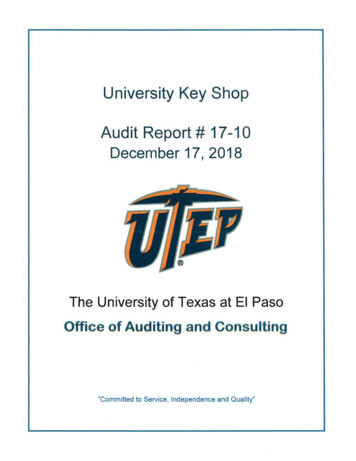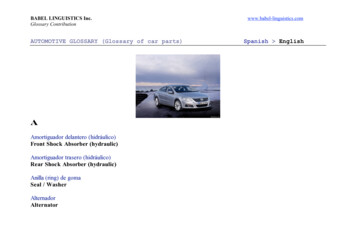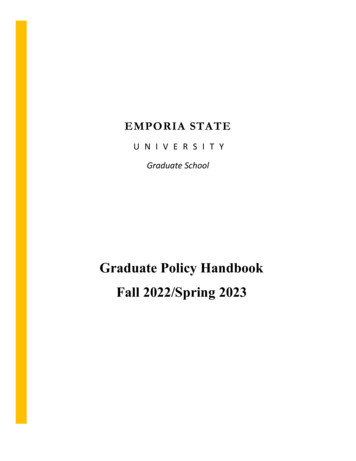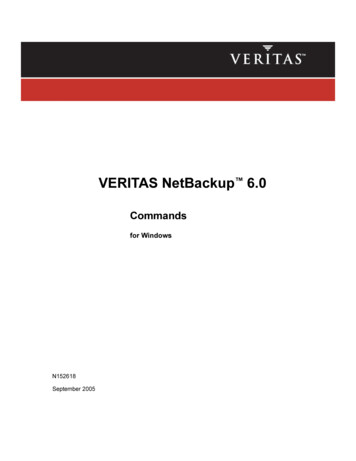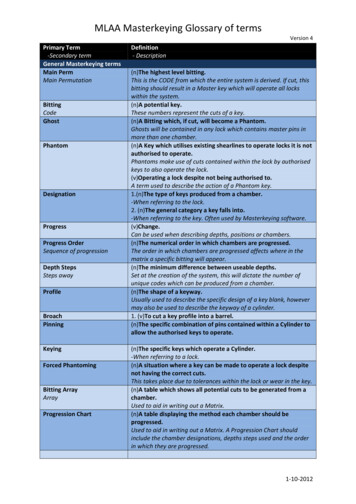
Transcription
MLAA Masterkeying Glossary of termsVersion 4Primary Term‐Secondary termGeneral Masterkeying termsMain PermMain essProgress OrderSequence of progressionDepth StepsSteps awayProfileBroachPinningKeyingForced PhantomingBitting ArrayArrayProgression ChartDefinition‐ Description(n)The highest level bitting.This is the CODE from which the entire system is derived. If cut, thisbitting should result in a Master key which will operate all lockswithin the system.(n)A potential key.These numbers represent the cuts of a key.(n)A Bitting which, if cut, will become a Phantom.Ghosts will be contained in any lock which contains master pins inmore than one chamber.(n)A Key which utilises existing shearlines to operate locks it is notauthorised to operate.Phantoms make use of cuts contained within the lock by authorisedkeys to also operate the lock.(v)Operating a lock despite not being authorised to.A term used to describe the action of a Phantom key.1.(n)The type of keys produced from a chamber.‐When referring to the lock.2. (n)The general category a key falls into.‐When referring to the key. Often used by Masterkeying software.(v)Change.Can be used when describing depths, positions or chambers.(n)The numerical order in which chambers are progressed.The order in which chambers are progressed affects where in thematrix a specific bitting will appear.(n)The minimum difference between useable depths.Set at the creation of the system, this will dictate the number ofunique codes which can be produced from a chamber.(n)The shape of a keyway.Usually used to describe the specific design of a key blank, howevermay also be used to describe the keyway of a cylinder.1. (v)To cut a key profile into a barrel.(n)The specific combination of pins contained within a Cylinder toallow the authorised keys to operate.(n)The specific keys which operate a Cylinder.‐When referring to a lock.(n)A situation where a key can be made to operate a lock despitenot having the correct cuts.This takes place due to tolerances within the lock or wear in the key.(n)A table which shows all potential cuts to be generated from achamber.Used to aid in writing out a Matrix.(n)A table displaying the method each chamber should beprogressed.Used to aid in writing out a Matrix. A Progression Chart shouldinclude the chamber designations, depths steps used and the orderin which they are progressed.1‐10‐2012
MLAA Masterkeying Glossary of termsVersion 4Forms of MasterkeyingStandard SystemRotating Constant SystemHold and Vary SystemPositional SystemMulti‐Profile SystemKeyed Alike SystemKeyed Different SystemKeyed to DifferMaison keyMaisonCross Key SystemLevel 1 SystemLevel 2 SystemLevel 3 SystemLevel 4 SystemLevel 5 SystemLevel 6 System(n)A system where chambers retain their original designations.In this form of masterkeying chambers receive designations at thecreation of the system and remain unchanged throughout the life ofthe system.(n)A system where chambers may change their designations.Chambers will usually alternate between producing keys orremaining constant.There are strict rules to this which must be adhered to in order tomaintain system integrity.(n)A system which uses partially loaded locks to restrict access.Multiple keys are given access to a lock by leaving chambers emptyor using “universal” pins. Keys are prevented from operating a lockby loading specific chambers will lock that key out.Kaba Quattro is an example of a locking system that uses PositionalMasterkeying as standard.(n)A system which utilises more than one key profile.This system may utilise a profile family which contains profiles thatcould be described as servant and master.(n)A system where all locks are keyed to the same combination.(n)A system where all locks are on a unique combination.A Keyed Different system should never contain a Master key.(v)Allowing a group of lower level keys to operate a commondoor.Generally done by utilising “universal” chambers which allow allkeys within a specific group to pass through unhindered.(n)A system which makes use of “Incidental Master keys”Incidental keys are identified, cut and used to achieve masterkeying.Conventional Master keys and Change keys may also be used.(n)A system where one position is progressed.A Two‐tiered system.(n)A system where two positions are progressed.A Three‐tiered system, including Incidental Masters.(n)A system where three positions are progressed.A Four tiered system, including Incidental Masters.(n)A system where four positions are progressed.A Five tiered system, including Incidental Masters.(n)A system where five positions are progressed.A Six tiered system, including Incidental Masters.(n)A system where six positions are progressed.A Seven tiered system, including Incidental Masters.1‐10‐2012
MLAA Masterkeying Glossary of termsVersion 4Masterkeying‐related terms relating to the LOCKSLock(n)The complete Lock.Includes the Cylinder and Barrel.Cylinder(n)The part of the lock which contains the pinning.Includes the Barrel.Barrel(n)The component of the Cylinder that the key slides into.CoreEach LOCK contains at least one CYLINDER. Each Cylinder containsPlugat least one BARREL.Bottom Pins(n) Cylindrical tumblers which prevent a Barrel from being turnedunless the correct key is used. Direct contact with the Key.Regardless of being above or below Top Pins, Bottom Pins will makedirect contact with the key.Top Pins(n)Cylindrical tumblers which prevent a Barrel from being turnedunless the correct key is used. Direct contact with the spring.Used in conjunction with a spring and Bottom Pin to create ashearline.Matched Top Pins(n)Individually sized Top Pins to create a stack height withinStacked Top Pinsspecific tolerances.Shearline1. (n)The point within a Cylinder where the tumblers must becorrectly aligned to allow the Barrel to turn.Usually where the Barrel makes contact with the inside of theCylinder.2. (n)The point where two separate objects meet.Where the Top Pin meets the Bottom Pin is a Shearline. Thisdefinition requires context.Tumbler(n)Individually sized objects causing obstruction within a Cylinder,until correctly aligned with a Key.Generic term which can be used to describe a wide range of suchobjects.Masterkeying‐related terms relating to the KEYSTop Master Key(n)The highest level Master Key in a system.TMKShould operate all Mastered locks within a system.Master Key1. (n)Any key which has keys or codes below it in the hierarchy.MKGeneric term referring to ALL levels of Master keys. Alternate termsshould be used if the intent is to describe a specific level of Master.This term should NOT be used for Selective keys.Change Key(n)A key which has NO keys or codes below it in the hierarchy.CKA change is the lowest possible level of key and should differ fromthe MP in every progressed position.1‐10‐2012
MLAA Masterkeying Glossary of termsVersion 4Selective KeySub‐Master KeyIncidental Master KeyLevel 1 Incidental MasterLevel 2 Incidental MasterLevel 3 Incidental MasterConstruction KeyControl KeyDesignated Master KeyGrand Master KeyGMKGreat‐Grand Master KeyGGMK(n)A key that is able to work a selection of locks across a range ofsub‐masters without creating phantoms.This must be achieved by designating specific position to contain aunique cut. All other positions must match the immediate Master.(in PM7, the “Key Above”)This term should not be used for Change keys or Master keys.(n)A Master key which has a Master key above it in the hierarchy.This term refers only to the fact that this Master is not the TMK. Thisterm may be used for ALL types of Master Key.(n)A Master key which utilises Main Perm cuts in positions alsoused to generate Change Keys.Generic term referring to ALL levels of Incidental key.When describing the number of tiers or levels a system has,Incidental keys should not be included as a separate level.(n)An Incidental Master Key which contains ONE Main Perm cut ina chamber designated for generating Change Keys.This Master key will operate a group of 4 change keys.(n)An Incidental Master Key which contains TWO Main Perm cutsin chambers designated for generating Change Keys.This Master key will operate a group of 16 change keys.(n)An Incidental Master Key which contains THREE Main Permcuts in chambers designated for generating Change Keys.This Master key will operate a group of 64 change keys.(n)A key designed for short term use with the intention of beinglocked out upon completion of a project.Construction keys can be created using a variety of methodsdepending on the locking system used. Common methods include,“Half Cut” and “Lost Ball”. These terms are not defined in thisglossary.(n)A key used to remove Interchangeable Cores.Control keys are used in a range of locking systems and are notfurther defined in this glossary.This term should not be used for a Master key.(n)A Master key which contains Main Perm cuts in chambers notused to produce any other type of key.“Standard” Master keys. To avoid confusion, this term should onlybe used when differentiating between designed master keys andIncidental Master keys.(n)A Master key which has one level of designated Master keysbelow it in the hierarchy.Top level key in a three tier system.This term should not be used for Incidental keys.(n) A Master key which has two levels of designated Master keysbelow it in the hierarchy.Top level key in a four tier system.This term should not be used for Incidental keys.1‐10‐2012
MLAA Masterkeying Glossary of termsVersion 4Masterkeying AcronymsMPMKGMKGGMKCKIKXKNMCMTASOPCONCTRLMain PermutationMaster KeyContext should be used to ensure that the intended definition isclear.Grand Master KeyGreat Grand Master KeyChange KeyLevel 1 Selective Key(PM7 Term) Selective Key operating below a single MK.Level 2 Selective Key(PM7 Term) Selective Key operating below a single GMK.Non‐ Mastered CylinderA cylinder within a system which the TMK does not operate. Thistype of lock should be considered special and only used in certainsituations.Maison to AcceptNotation stored against a cylinder to indicate that it is to be MaisonKeyed.Sequence Of ProgressionProgress Order – the order in which chambers are progressed.Construction KeyControl KeyTerms which are now actively discouraged:The following terms are actively discouraged on the grounds that they may cause confusion due totheir varied definitions in the past.InterchangeInterchange KeyCross KeySMK ‐as Sub Master Keying.CK ‐as Construction Key.IK ‐as anything but Level 1 Selective Key.[3] Level System –as a description of the structure of a system. Preferred term for describing levelsis “Tiers” so as to not get confused with the term “Level 1 System”.Ghost KEYS – Ghost now only refers to uncut bittings.Phantom CODES – Phantom now only refers to cut keys.1‐10‐2012
MLAA Masterkeying Glossary of termsVersion 4Example Diagrams:The following diagrams may be useful in further clarification of the definitions as specified in theGlossary.Fig 1: Hierarchy of a System (KEYS)LEGENDGMKTop level Master KeyMKSub Master keysCKChange KeysXKLevel 2 Selective keyIKLevel 1 Selective keyCHAMBER DESIGNATIONSXM CCCThis system is a 3 tiered system. It is a Level 5 system because 5 chambers have been progressed.There are 4 potential MKs below the GMK. (only two shown)There are 4 potential XKs below the GMK. (only one shown)Each MK has 64 potential CKs and 4 potential IKs.Incidental Keys exist but are not shown.Based on the Chamber Designations shown, the GMK has been generated by cutting the Main Perm.1‐10‐2012
MLAA Masterkeying Glossary of termsVersion 4Fig 2: Selective Keys6517Building A23Building B48910AX1 and AX2 are Level 1 Selective keys (IKs).They are able to work a selection of locks which arealready operated by the A Master.BX1 and BX2 are also Level 1 Selective keys (IKs).They are able to work a selection of locks which arealready operated by the B Master.KEYS LISTGAll locksAAll locks in Building AA1 Door 1A2 Door 2A3 Door 3A4 Door 4BAll locks in Building BB1 Door 5B2 Door 6B3 Door 7B4 Door 8B5 Door 9B6 Door 10AX1 Doors 1 & 3AX2 Doors 2, 3 & 4BX1 Doors 5 & 7BX2 Doors 6 & 10GX1 Doors 1 & 6GX2 Doors 2 & ectiveSelectiveSelectiveSelectiveGX1 and GX2 are Level 2 Selective keys (XKs). They are able to work a selection of locks which arealready operated by the G Grand Master.1‐10‐2012
MLAA Masterkeying Glossary of termsVersion 4Fig 3: Anatomy of a Code MatrixMP: 4 1 6 3Depths: 0 0 0 2SOP: 0 0 0 3Desig:CSAMPLE CODING MATRIX0 52 22 1C 666 4 1 6 77788881379999966661379444411116666999988881379 Main Perm – The bitting the whole system is derived from. If cut, this will become the TMK. Progression Chart – This indicates that only the last three chambers are to be progressed.‐The cuts will be progressed in steps of 2.‐The order in which the chambers are to be progressed. This will not affect the codes displayed in theMatrix, but will affect WHERE they appear. The recommended method of writing the codes out isshown in this figure.‐ The last three chambers are all designated for the production of Change Keys. The first threechambers are being held constant. Bitting Array – All possible cuts are displayed in the chambers marked for progression. This tablehas been drawn up based on the parameters set by the Progression Chart. Change Keys – As specified in the Progression Chart, only the last three chambers are different tothe MP. There must be NO Main Perm cuts contained in these positions.1‐10‐2012
MLAA Masterkeying Glossary of termsVersion 4Fig 4: Incidental KeysThe following Table shows all the Incidental keys that operate within the system drawn up in Fig 3.With three chambers designated for generating Change keys there are going to be 48 IncidentalMaster Keys created automatically.Level 1 Incidental Masters48 keys each with one Main Perm cut, each operating a group of 4 Change keys.Example: 416125416125 – 416145 – 416165 – 416185Operates the following change keys:416525 – 416545 – 416565 – 416585416121 – 416123 – 416127 – 416129416725 – 416745 – 416765 – 416785416925 – 416945 – 416965 – 416985Example: 416101416101 – 416103 – 416107 – 416109Operates the following change keys:416501 – 416503 – 416507 – 416509416701 – 416703 – 416707 – 416709416121 – 416141 – 416161 – 416181416901 – 416903 – 416907 – 416909Example: 416321416321 – 416341 – 416361 – 416381Operates the following change keys:416323 – 416343 – 416363 – 416383416327 – 416347 – 416367 – 416387416121 – 416521 – 416721 – 416921416329 – 416349 – 416369 – 416389Level 2 Incidental Masters12 keys each with two Main Perm cuts, each operating a group of 16 Change keys.Example: 416105Operates the following Change keys:416105416121 416141 416161 416181416505416123 416143 416163 416183416705416127 416147 416167 416187416905416129 416149 416169 416189Example: 416325Operates the following Change keys:416325416121 416521 416721 416921416345416123 416523 416723 416923416365416127 416527 416727 416927416385416129 416529 416729 416929Example: 416301Operates the following Change keys:416301416121 416141 416161 416181416303416521 416541 416561 416581416307416721 416741 416761 416781416309416921 416941 416961 4169811‐10‐2012
(n)A Master key which has one level of designated Master keys below it in the hierarchy. Top level key in a three tier system. This term should not be used for Incidental keys. Great‐Grand Master Key GGMK (n) A Master key which has two levels of designated Master keys below it in the hierarchy.
